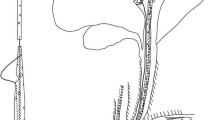Abstract
Introduction
Recently prophylactic placement of a trans-sphincteric pancreatic stent has successfully been applied to prevent post-endoscopic retrograde cholangiopancreatography (ERCP) pancreatitis. Rescue ERCP and emergency application of small-caliber pancreatic stents during the early course of post-ERCP pancreatitis as a possible endoscopic therapy has not been reported yet.
Methods
All patients who underwent ERCP were hospitalized for at least 24 h, with routine laboratory testing of amylase levels. Out of 1,225 ERCPs, evolution of severe post-ERCP pancreatitis was anticipated in six consecutive patients, based on severe pancreatic pain attack, more than tenfold elevation of serum amylase levels at 8 and 24 h, and moderate rise of white blood cell (WBC) and C-reactive protein (CRP) levels. Rescue ERCP and emergency application of small-caliber (4-5F, 4-cm, Geenen stent) pancreatic stents were successfully performed in all patients within 8–20 h after the initial ERCP.
Results
Moderate to severe papillary oedema was observed in all patients during the rescue ERCP. Pancreatic pain was promptly reduced after the rescue pancreatic drainage procedure and completely diminished within 24 h after pancreatic stenting. Serum amylase levels were exponentially reduced and normalized within 72 h in all patients; no pancreatic necrosis or any other late complications were observed. Pancreatic stents could be safely removed a few days later.
Conclusion
Rescue pancreatic stenting with small-caliber prophylactic pancreatic stents seems to be a safe and effective procedure that might be feasible to stop the evolution of severe post-ERCP pancreatitis, but prospective controlled studies are clearly demanded to support this innovative approach.


Similar content being viewed by others
References
Freeman ML, DiSario JA, Nelson DB, Fennerty MB, Lee JG, Bjorkman DJ, Overby CS, Aas J, Ryan ME, Bochna GS, Shaw MJ, Snady HW, Erickson RV, Moore JP, Roel JP (2001) Risk factors for post-ERCP pancreatitis: a prospective, multicenter study. Gastrointest Endosc 54(4):425–434
Masci E, Mariani A, Curioni S, Testoni PA (2003) Risk factors for pancreatitis following endoscopic retrograde cholangiopancreatography: a meta-analysis. Endoscopy 35(10):830–834
Cheng CL, Sherman S, Watkins JL, Barnett J, Freeman M, Geenen J, Ryan M, Parker H, Frakes JT, Fogel EL, Silverman WB, Dua KS, Aliperti G, Yakshe P, Uzer M, Jones W, Goff J, Lazzell-Pannell L, Rashdan A, Temkit M, Lehman GA (2006) Risk factors for post-ERCP pancreatitis: a prospective multicenter study. Am J Gastroenterol 101(1):139–147
Andriulli A, Caruso N, Quitadamo M, Forlano R, Leandro G, Spirito F, De Maio G (2003) Antisecretory vs. antiproteasic drugs in the prevention of post-ERCP pancreatitis: the evidence-based medicine derived from a meta-analysis study. JOP 4(1):41–48
Smithline A, Silverman W, Rogers D, Nisi R, Wiersema M, Jamidar P, Hawes R, Lehman G (1993) Effect of prophylactic main pancreatic duct stenting on the incidence of biliary endoscopic sphincterotomy-induced pancreatitis in high-risk patients. Gastrointest Endosc 39(5):652–657
Tarnasky PR, Palesch YY, Cunningham JT, Mauldin PD, Cotton PB, Hawes RH (1998) Pancreatic stenting prevents pancreatitis after biliary sphincterotomy in patients with sphincter of Oddi dysfunction. Gastroenterology 115(6):1518–1524
Fazel A, Quadri A, Catalano MF, Meyerson SM, Geenen JE (2003) Does a pancreatic duct stent prevent post-ERCP pancreatitis? A prospective randomized study. Gastrointest Endosc 57(3):291–294
Brackbill S, Young S, Schoenfeld P, Elta G (2006) A survey of physician practices on prophylactic pancreatic stents. Gastrointest Endosc 64(1):45–52
Elta GH (2008) Temporary prophylactic pancreatic stents: which patients need them? Gastrointest Endosc 67(2):262–264
Verma D, Gostout CJ, Petersen BT, Levy MJ, Baron TH, Adler DG (2007) Establishing a true assessment of endoscopic competence in ERCP during training and beyond: a single-operator learning curve for deep biliary cannulation in patients with native papillary anatomy. Gastrointest Endosc 65(3):394–400
Freeman ML (2003) Understanding risk factors and avoiding complications with endoscopic retrograde cholangiopancreatography. Curr Gastroenterol Rep 5(2):145–153; Review
Singh P, Das A, Isenberg G, Wong RC, Sivak MV Jr, Agrawal D, Chak A (2004) Does prophylactic pancreatic stent placement reduce the risk of post-ERCP acute pancreatitis? A meta-analysis of controlled trials. Gastrointest Endosc 60(4):544–550
Saad AM, Fogel EL, McHenry L, Watkins JL, Sherman S, Lazzell-Pannell L, Lehman GA (2008) Pancreatic duct stent placement prevents post-ERCP pancreatitis in patients with suspected sphincter of Oddi dysfunction but normal manometry results. Gastrointest Endosc 67:255–261
Elta GH (2008) Temporary prophylactic pancreatic stents: which patients need them? Gastrointest Endosc 67(2):262–264
Andriulli A, Forlano R, Napolitano G, Conoscitore P, Caruso N, Pilotto A, Di Sebastiano PL, Leandro G (2007) Pancreatic duct stents in the prophylaxis of pancreatic damage after endoscopic retrograde cholangiopancreatography: a systematic analysis of benefits and associated risks. Digestion 75(2–3):156–163
Das A, Singh P, Sivak MV Jr, Chak A (2007) Pancreatic-stent placement for prevention of post-ERCP pancreatitis: a cost-effectiveness analysis. Gastrointest Endosc 65(7):960–968. Epub 2007 Feb 28
Testoni PA, Bagnolo F (2001) Pain at 24 hours associated with amylase levels greater than 5 times the upper normal limit as the most reliable indicator of post-ERCP pancreatitis. Gastrointest Endosc 53(1):33–39
Testoni PA, Bagnolo F, Caporuscio S, Lella F (1999) Serum amylase measured four hours after endoscopic sphincterotomy is a reliable predictor of postprocedure pancreatitis. Am J Gastroenterol 94(5):1235–1241
Safrany L, Cotton PB (1981) A preliminary report: urgent duodenoscopic sphincterotomy for acute gallstone pancreatitis. Surgery 89(4):424–428
Freeman ML, Overby C, Qi D (2004) Pancreatic stent insertion: consequences of failure and results of a modified technique to maximize success. Gastrointest Endosc 59(1):8–14
Lawrence C, Cotton PB, Romagnuolo J, Payne KM, Rawls E, Hawes RH (2007) Small prophylactic pancreatic duct stents: an assessment of spontaneous passage and stent-induced ductal abnormalities. Endoscopy 39(12):1082–1085. Epub 2007 Sep 21
Author information
Authors and Affiliations
Corresponding author
Rights and permissions
About this article
Cite this article
Madácsy, L., Kurucsai, G., Joó, I. et al. Rescue ERCP and insertion of a small-caliber pancreatic stent to prevent the evolution of severe post-ERCP pancreatitis: a case-controlled series. Surg Endosc 23, 1887–1893 (2009). https://doi.org/10.1007/s00464-008-0199-z
Received:
Accepted:
Published:
Issue Date:
DOI: https://doi.org/10.1007/s00464-008-0199-z




